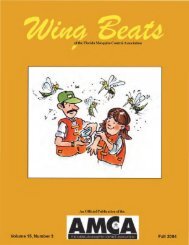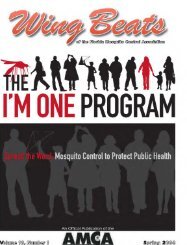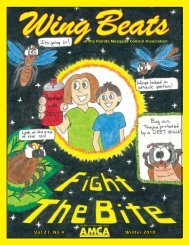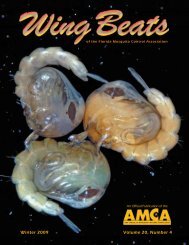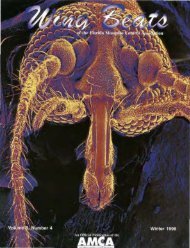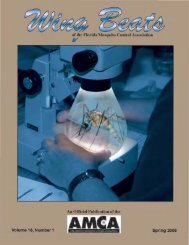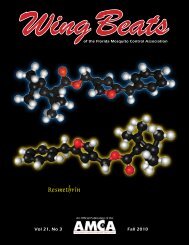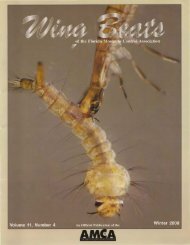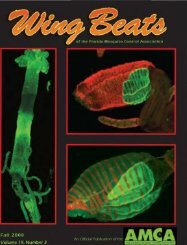Volume 23 Number 1 - Wing Beats - Wing Beats - Florida Mosquito ...
Volume 23 Number 1 - Wing Beats - Wing Beats - Florida Mosquito ...
Volume 23 Number 1 - Wing Beats - Wing Beats - Florida Mosquito ...
You also want an ePaper? Increase the reach of your titles
YUMPU automatically turns print PDFs into web optimized ePapers that Google loves.
32<br />
1. Severe organic pollution; see<br />
Figures 4 and 5. Turbid and foulsmelling<br />
water, associated with<br />
fallen tree branches, trash, and<br />
other rotting materials, provided<br />
particularly favorable habitat<br />
for Cx quinquefasciatus larvae<br />
when there were no fish in a pool.<br />
This ecotype was particularly<br />
common during the first year after<br />
Figure 6: The “ecologically productive without pollution” ecotype<br />
supported large populations of aquatic insects and provided favorable<br />
habitat for Anopheles larvae, which avoided fish predation by clinging to<br />
floating pine needles, floating sticks, or grass around the edge of a pool.<br />
Figure 7: The “oak leaves” ecotype provided favorable habitat for Culex<br />
and Anopheles larvae, but supported relatively few fish. A <strong>Mosquito</strong><br />
Control sign with information for homeowners is in the background.<br />
Spring 2012 <strong>Wing</strong> <strong>Beats</strong><br />
Katrina, with the pollution declining<br />
gradually after that, so it was<br />
much less noticeable by the third<br />
year. Fish generally provided<br />
effective mosquito control in this<br />
ecotype, except when organic<br />
loading was extreme. We were<br />
particularly concerned about the<br />
low oxygen concentrations and<br />
high levels of ammonia that could<br />
accompany organic pollution. It<br />
turned out that oxygen was not<br />
a problem. Gambusia thrived in<br />
many pools with no measurable<br />
oxygen. However, high ammonia<br />
concentrations of 10-40 ppm,<br />
though rare in occurrence, were<br />
distinctly associated with smaller<br />
fish populations.<br />
2. Ecologically productive<br />
without pollution; see Figure 6.<br />
This ecotype lacked the putrid<br />
conditions and numerous Cx<br />
quinquefasciatus larvae so characteristic<br />
of organically polluted<br />
pools. These pools were somewhat<br />
saline, suggesting that they<br />
had been flooded with brackish<br />
water from Lake Pontchartrain.<br />
Aquatic insects such as water<br />
boatmen, dragonfly nymphs,<br />
and water striders were often<br />
abundant, along with Anopheles<br />
and Cx salinarius larvae.<br />
Conditions favorable for one<br />
seemed favorable for all. Gambusia<br />
did well in this ecotype<br />
and eliminated Culex larvae,<br />
but Anopheles larvae frequently<br />
coexisted in small numbers with<br />
the fish, apparently because the<br />
larvae could avoid fish predation<br />
by clinging to floating pine<br />
needles, small floating sticks, or<br />
grass around the edge of a pool.<br />
3. Oak leaves; see Figure 7. Pools<br />
with a large number of oak leaves,<br />
and distinctively brown water from<br />
tannins in the leaves, provided<br />
favorable habitat for Culex and<br />
Anopheles larvae and water<br />
boatmen. Gambusia survived in<br />
this ecotype, but their populations<br />
were generally low. <strong>Mosquito</strong>



